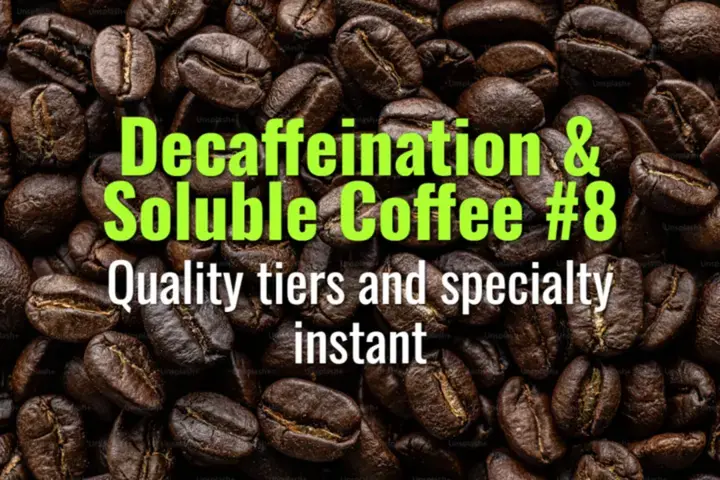Quality tiers and specialty instant
The different quality tiers in instant coffee production, how specialty instant differs from commodity products, and the innovations driving this segment.
- Coffee Basics Nerds
- 1 min read
Article 8 of 12 in Decaffeination & Soluble Coffee/

Traditional Quality Tiers
- Commodity Instant Coffee:
- Typically made from low-grade robusta.
- Spray-dried for cost efficiency.
- Flavor: harsh, bitter, thin.
- Mid-Tier Instant:
- Blend of arabica and robusta.
- Sometimes freeze-dried for better flavor retention.
- Flavor: smoother but still simplified.
- Premium Instant:
- 100% arabica.
- Often freeze-dried, sometimes micro-ground arabica added.
- Flavor: closer to brewed coffee.
Specialty Instant Coffee
- Raw Material: High-quality specialty-grade arabica.
- Processing: Almost exclusively freeze-dried for flavor integrity.
- Micro-Ground Addition: Tiny percentage of freshly roasted and ground coffee blended into instant for aroma boost.
- Transparency: Producers often list origin, variety, and processing method—mirroring specialty roasted coffee.
- Flavor Profile: Retains distinct terroir character (e.g., fruity Ethiopian, chocolatey Colombian).
Market Innovations
- Single-Origin Instants: Focus on origin expression.
- RTD (Ready-to-Drink) Integration: Specialty instant used in cans, sachets, or concentrates.
- Eco-Friendly Packaging: Compostable sachets, recyclable jars.
- Barista Applications: Used in cocktails, baking, and as travel-friendly specialty brews.
Consumer Appeal
- Convenience + quality = growth segment.
- Appeals to travelers, busy professionals, and those without brew gear.
- Specialty instant bridges the gap between everyday convenience and craft coffee culture.
Summary
Instant coffee spans from commodity robusta-based powders to specialty freeze-dried single-origins. Specialty instant emphasizes arabica quality, terroir expression, and innovative processing, giving consumers a fast yet authentic specialty coffee experience.
You might also like:
- Tags:
- Specialty Coffee
- Flavor Profile
- High Quality
- Brewed Coffee
- Coffee Culture
- Ground Coffee
- Specialty Grade
- Roasted Coffee
- Coffee Flavor
- Instant Coffee
- Flavor Integrity
- Arabica Robusta
- Terroir Expression
- Processing Method
- Single Origin
- Eco Friendly
- Ready Drink
- Freshly Roasted
- Better Flavor
- Quality Specialty
- Arabica Quality
- Single Origins
- Coffee Experience